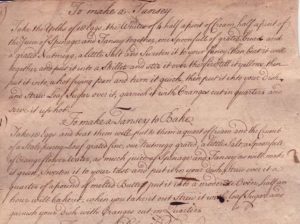| Look closely at the recipe page. What clues show that this recipe page might have come from a long time ago? |
 |
| You:
|
Historian:
The page looks worn on edges, the recipe is handwritten, and some of the terms are unfamiliar — spinage, tansey, loaf sugar, in blood pudding, penny loaves. There are unfamiliar measurements — either a grated nutmeg, or ½ nutmeg, instruction to “stir it over the fire”. |
| How does this recipe page look compared to recipes today? Give examples. |
| You:
|
Historian:
It’s handwritten, with splotches of ink on page. The recipes are listed in a number order, not by topic, measurements are larger — 18 eggs, quart of milk; less exact measurements such as “one spoonfull” and “sweeten to taste,” “½ nutmeg,” “a little thyme, winter savory” etc. |
| What might these non-exact measurements tell us about the cook? |
| You:
|
Historian:
They were experienced in cooking, knew how much “a little” is or how big a “spoonfull” is. |
|
How would you find a specific recipe in this book? Could you find one of a specific type?
|
| You:
|
Historian:
You would have to know the book or flip through the pages — the recipes are only in order of when they were written in. |
| How many people do you think this is for? How can you tell? |
| You:
|
Historian:
A guess — 2-3 eggs per person 18 eggs in total, 6-9 people. The saved recipes were usually the special recipes, used for large social family gatherings |
| What do you think spinage is? |
| You:
|
Historian:
Spinach. |
| Look at the picture of a whole nutmeg and compare it to already grated nutmeg. How do these compare? How would you use the whole nutmeg mentioned in recipe? |
 |
| You:
|
Historian:
Grate it. |
| Why don’t people usually buy a whole nutmeg today? |
| You:
|
Historian:
It’s easier to buy already grated, and today’s recipes call for exact measurements. |
| Why do recipes have exact measurements? |
| You:
|
Historian:
More people cook today, and they have different levels of experience. Also, people experiment with cooking unfamiliar to them, so it helps to have exact measurements when trying something you don’t know. |
| What hint is there that the tansey was cooked over a flame in an open hearth? |
| You:
|
Historian:
“Stir it over the fire” |
| What are the last toppings to be put on the tansey? |
| You:
|
Historian:
Loaf sugar and orange quarters |
| Look at the sugar tongs in the kit box. These were used to get sugar pieces from the loaf sugar. Loaf sugar was a compact cone of sugar. How do you think the tongs were used? |
 |
| You:
|
Historian:
The pincers were used to break off smaller pieces from the loaf sugar. |
| One spice is used to make Tansey which was not available to everyone in Colonial America. Which do you think this is? Where do we get spices today? |
| You:
|
Historian:
Nutmeg — it was imported from Grenada and Brazil and available to upper classes. Only the upper classes could afford to get ingredients that were imported from exotic places. Today, it is much easier for us to grow our own spices as well as import them from many countries. |
| Look at the colonial recipe and its modern version. How do they compare? |
| You:
|
Historian:
In the modern version — there’s no tansey, it has specific measurements, and uses spinach (not juice of), no sugar, it says how many people served, uses smaller amounts, and is cooked over high heat rather than a flame. |